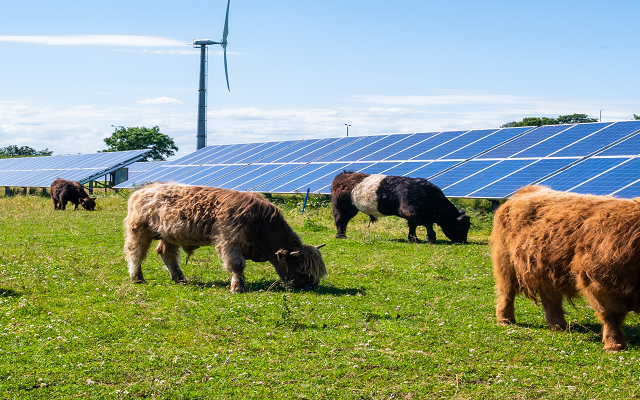Land Business Update | Week Commencing 30th October 2023
Welcome to our fortnightly update on key land management, farming, planning, forestry, environmental and energy issues.
Farming
Tests and trials – fourth call to help develop Defra’s Environmental Land Management schemes
Land managers who would like to take part can submit an application by 30th November 2023. Defra would like to explore topics including: what is considered quality advice by farmers? How can schemes evolve to deliver targets? How can Defra support collaboration between farmers to deliver more complex actions? If you are interested in taking part, more information can be found here.
Energy
Agrivoltaics alone could exceed the EU’s target for solar generation by 2030
Agrivoltaics, which is combining farming and solar photovoltaic electricity production by placing solar panels on tall frames above crops or grass or fruit, could generate more than the EU’s target of 720 GW of solar energy generation by 2030 if it was done on 1% of EU utilised agricultural area (UAA). A study by the EU’s Joint Research Centre says that a plan for agrivoltaics is essential to deliver the EU’s REPowerEU plan to reduce the bloc’s reliance on fossil fuels. However, the study also says that the lack of a clear definition of agrivoltaics is a significant obstacle, as is its eligibility for agricultural subsidies and for taxation.
Environment
Countryside Stewardship Facilitation Fund opens for a new round
This element of the scheme pays for facilitators to advise farmers and land managers on how to work together to deliver environmental benefits. Previous rounds have helped 224 groups with 6,000 land managers. This round pays up to £50,000 per group over 3 years for a facilitator to work with the group. Both existing and new groups are eligible for the funding. Applications must be made by 15th January 2024. As we have previously reported, this type of approach is an environmental success story. A review found that facilitated groups had:
- Improved environmental outcomes through better alignment of option uptake and land manager capability.
- Option richness and diversity were significantly greater in facilitated agreements compared with other AES agreements.
- A positive impact on connectivity of habitats, leading to more resilient landscapes.
- There were also indications that group membership was encouraging uptake of more challenging options.
- A wide range of social capital benefits including improved trust, collaboration, communication and relationships.
Natural Flood Management Accelerator Programme to fund 23 projects in Wales
The Welsh Government programme will run for two years and invest £4.6m in projects to deliver nature-based management solutions across all major river catchments. The funding will support the expansion of wetland and woodland habitats, reduction of flood risk to up to 2,000 properties and hopefully boost the number of NFM schemes across the country. Recently approved projects include plans to plant additional woodland to slow overland flows, riparian buffer strips and leaky dam construction.
Big Butterfly Count results – a better year in 2023 but…
More butterflies were counted per report sent in compared with last year’s all time low (12 butterflies per count vs 9). This is good news and possibly due to this year’s mixed weather leading to lots of green food plants being available for caterpillars, and plenty of nectar-rich flowers for adult butterflies. However, the longer-term trend over the 13 years that the Count has run is that many species have significantly decreased. Whilst butterflies, moths and many other species can generally cope with variable weather, one of the biggest threats is habitat loss. Butterfly Conservation, which runs the Count, has some useful factsheets on managing land and habitats for butterflies. This year, 95,000 people took part and submitted returns for 137,000 individual ‘counts’, which take 15 minutes to do.
Biodiversity Net Gain (BNG) plan draft template and guidance published
Once BNG becomes law in January 2024, developers will be legally required to submit a biodiversity gain plan after planning consent has been given by the local planning authority (LPA). When the BNG plan is approved, it will discharge the BNG condition attached to the planning consent. LPAs will have to give their written approval before any development can start. To help developers, Defra has published a draft template and associated guidance. The BNG plan should cover the developer’s BNG strategy, including mitigation measures to minimise impacts of the development on existing site habitats, where and how the target BNG will be delivered, the completed biodiversity metric tool, as well as a post-development habitat survey and map.
Forestry
New project aims to bring back woodlands into active management and support woodland creation
Delivered by the Sylva Foundation and thanks to further funding from the Forestry Commission, the Protect Improve Expand Sustain (PIES) project is now open to further applications. With up to £3,000 worth of free advice available to eligible land managers in England, the project offers a site visit and a follow-up tailored report by an independent woodland expert. Applicants can also apply for further support, including the English Woodland Creation Offer (EWCO) and being offered the Grown in Britain Forest qualification which supports landowners to make the most out of their woodland resources.
Rural economy and property
Business rates due to rise in 2024
Business rates are expected to rise by around 6-7% when they are recalculated in April as the government’s multiplier is based on September’s inflation rate (consumer price inflation). The British Retail Consortium has said that it will put pressure on businesses, some of which may increase prices and so have an inflationary effect. It has called for the government to freeze rates at their current level.
Tenant protections in Scotland extended for a further six months to April 2024
The protections, first introduced by the Cost of Living (Tenant Protection) Act 2022, include a temporary cap on most residential rent increases. The cap has been set at 3% until 31st March 2024 at the latest. Landlords can apply to the Rent Service Scotland to increase rents (by a maximum of 6%) if their costs have risen. There is also a moratorium on evictions, except in a limited number of circumstances, again until 31st March 2024, and an increase in the damages which can be awarded in cases of unlawful eviction. This is the final time these measures can be extended, unless the Scottish Government introduces a new act.
Turning the spotlight onto rural exception sites
An interesting new report has examined the low use of Rural Exception Sites (RESs) in England, which is a planning policy dating from 1991 that encourages affordable homes for local people on small plots of rural land that would not otherwise be granted permission for housing development. The policy can permit some market sale homes if they are needed to make the delivery of affordable housing units viable. The report states that only 14 of 91 rural authorities constructed any affordable homes on RESs in 2016 and 2017 – and almost 40% of those were in Cornwall. The report includes five recommendations:
- Supplying every parish council with information about the RES policy.
- Training Rural Housing Enablers to raise awareness about RESs.
- Developing guidance to incentivise landowners to release land for RESs (which can be worth @ £100,000 per hectare).
- Creating a national programme highlighting the policy.
- Producing a positive model for RES development, showcasing what the homes could look like.






